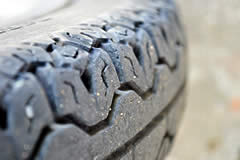What You Can Do To Help Minimize Tire Wear - Vol.280
Needing to replace tires more frequently due to tire wear is a waste of time and money, as well as a very big safety concern. Each vehicle we drive needs to have adequate tires that are in good condition, or it is not safe. There are five key elements to preventing or at least minimizing tire wear. By following these tips you can increase the lifespan of your tires and the safety of your passengers.

- Keep your vehicle in alignment: Most drivers have heard the term alignment at some time in their life, yet may not understand what it really means. In the simplest terms, alignment is the positioning of your wheels in context with your vehicle's frame. When your tires and wheels are aligned perfectly, they sit perpendicular to the road. However, over time tires become misaligned. When the front tires start to angle towards each other, it is a sign of Toe Wheel Misalignment, and the driver will often feel the steering pulling to one side or the other. When your tires and wheels start to angle closer to or away from each other on a vertical axis, this is a sign of Camber Wheel Misalignment. Either of these alignment issues will cause your tires to rub on the road surfaces in a manner that they shouldn't. As the tires rub on the sides, they wear down far more quickly than if the vehicle was properly aligned.
- Correct saggy springs and improper suspension: Your suspension is comprised of all of the parts and joints which allow you to have a smooth car ride. This will include tires and wheels, springs, struts, arms, and shock absorbers. Each of these many pieces needs to be connected properly and set to the correct tension, otherwise your suspension will be off and your tires will wear unevenly. If you suspect that your tire wear is caused by a suspension issue, it is advisable to check on the health of your springs, straightness of your struts, wearing on ball joints, wearing on bushings, and the wearing on your shock absorbers.
- Do not use tires with the wrong pressure: Tires that are under-inflated, or do not have enough air pressure, will suffer from tread wear. If a tire is missing even 5 PSI, it will move, bend, and pancake where it meets the road surface. Tires were not meant to run on their edges or sides, which is why tread was only placed on a specific circumference of the tire. Fortunately, this is one of the easiest tire wear causes to prevent. Every make and model of vehicle will have its own tire pressure guidelines, these can be found in your owner's manual and often inside the driver's side door panel. Make sure to keep your tires inflated to the PSI that is specified by the automaker. Also, make sure to travel with a good tire pressure gauge in your vehicle.
- Stop driving so aggressively: Anyone who has ever seen a car race will remember how quickly the drivers went through tires. This is because those tires were essentially being abused on the track. Standard tires were not meant for aggressive driving. Allowing your tires to squeal, stomping on your breaks, and taking corners too quickly are not only unsafe driving practices, they are also hell on your tire tread health.
- Purchase good tires: Tires are a perfect example of getting what you pay for. Unfortunately, purchasing four new tires for your vehicle can be an expensive expenditure, but a necessary one. We will not say that you must purchase the top of the line, most expensive tires on the market. At the very least you should, however, purchase tires that are mid grade. If you try to get out of the tire shop as cheap as possible, you will leave with tires that will suffer from tread wear much more quickly.
If your vehicle stays in alignment, your suspension is healthy, and you do not drive like a dragster, your tires and tread should last an average of sixty thousand miles. This is based on the understanding that you are not using cheap or used tires on your car, truck, or SUV.